Harriet Hubbard Ayer (post 1947)
Continued from: Harriet Hubbard Ayer
In 1944, Lever Brothers, the American affiliate of Unilever, acquired the Pepsodent company of Chicago, the makers of Pepsodent toothpaste. Pepsodent’s president, Charles Luckman [1909-1999], continued to head the new Pepsodent division of Lever Brothers but when Lever Brothers’ long-time president Francis A. Countway [1876-1955] retired in 1946 he selected Luckman to be his replacement.
As part of a program of diversification and regeneration Luckman engineered the Lever Brothers’ purchase of Harriet Hubbard Ayer in 1947 and Rayve Shampoo and Hedy Wave Home Permanents from Warner-Hudnut in 1948. Then, In 1949, Luckman announced that he would be moving the headquarters of Lever Brothers from Cambridge, Massachusetts into a new building to be built at 390 Park Avenue, New York – later named Lever House. The company’s divisions, including Pepsodent and Harriet Hubbard Ayer, would move there when the building was completed in 1952.
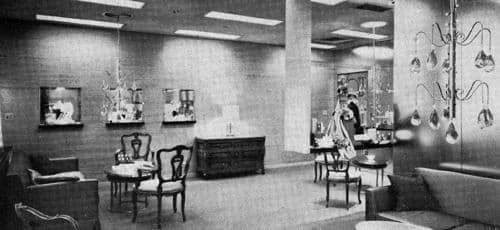
Above: 1952 Harriet Hubbard Ayer showrooms in Lever House at 390 Park Avenue, New York.
By the time Lever House was completed Charles Luckman was no longer the company president. Executives at Unilever, the London parent company, were alarmed by Luckman’s diversification and building program, the declining sales of Lever’s soap and shortening products and the fact that Lever Brothers’ balance sheet had moved into the red. In 1950, representatives were sent over from London and Luckman was forced to resign.
It seems clear that Luckman planned to turn Harriet Hubbard Ayer into a mass marketed line. Money was invested in the company and Lever Brothers were “going to get in there and sell like hell” (Time, July 28, 1947). Although Lillian Sefton Dodge stayed on for a time in an advisory capacity, Ralph P. Lewis – former vice-president in charge of sales of Elizabeth Arden Sales Corporation – became president of the division.
Unfortunately, things did not go as planned. Although the market for cosmetics and toiletries had been strong in the United States immediately after the end of Second World War, by 1948 demand had fallen and cosmetics sales were now in a buyers market with many stores returning unsold inventory. Demand increased in the 1950s but the decade ushered in a greater use of television advertising requiring large sales and/or good margins to support its cost.
Despite money being invested in new packaging, new products and advertising, Harriet Hubbard Ayer steadily lost money. Luckman had a keen understanding of advertising and it is possible that Harriet Hubbard Ayer may have turned a corner in the 1950s if he had stayed but there was a noticeable drop in promotion after he was forced to resign.
In an attempt to improve sales, Lever Brothers repackaged the entire Harriet Hubbard Ayer line again in 1952 in snow white jars and bottles with white, black and baked-in 22-carat gold motifs but this had little effect. In 1953, a desperate Lever Brother’s even tried to sell Harriet Hubbard Ayer door-to-door through their Retail Home Service Beauty Plan. Started in Washington D.C. with 120 trained ‘Beauty Consultants’, it was abandoned in 1954 when Lever Brothers announced they were selling the American business of Harriet Hubbard Ayer to Nestle-LeMur at a loss of US$3,000,000. The European arm of Harriet Hubbard Ayer remained with Unilever to be based in France.
Although the acquisition of Harriet Hubbard Ayer by Lever Brothers failed to revitalise the company in the American market some product developments during this time are worth noting.
In 1948, when the packaging was modernised, a number of existing products were rebadged with the Luxuria name including: Hand Cream, Night Cream, Special Astringent and Skin Tonic in 1948; and Eye Cream in 1949. These joined the exisiting Luxuria Cleansing Cream and Luxuria Face Powder.
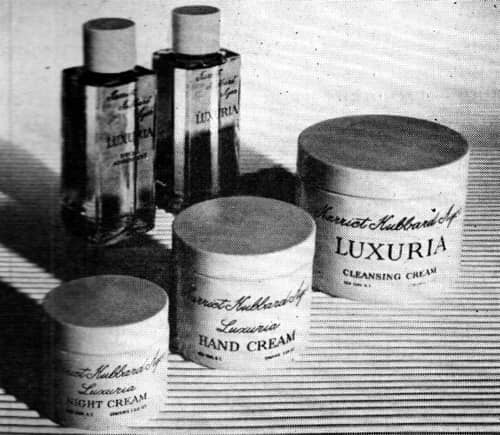
Above: 1948 Harriet Hubbard Ayer Luxuria Special Astringent, Skin Tonic, Night Cream, Hand Cream and Cleansing Cream in bottles and jars redesigned by Joseph Platt.
Also in 1948, the Harriet Hubbard Ayer Salon de Coiffure opened at 89 Rue du Faubourg, Paris.
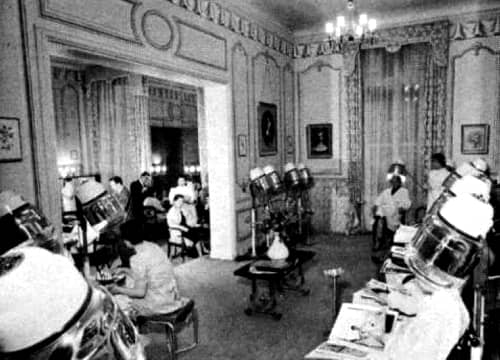
Above: 1954 Harriet Hubbard Ayer Salon de Coiffure.
The following year a range of hair-care products including a Home Permanent Kit was added to the Harriet Hubbard Ayer range, presumably using the product knowledge Lever Brothers gained with the purchase of Rayve Shampoo and Hedy Wave Home Permanents in 1948. These new products were introduced into the United States using the cachet of the Paris Salon de Coiffure with French fashion models and the Parisian hair stylist Roger Para.
See the newest in glamorous Paris hair styles, as presented by Monsieur Roger Para, straight from the Paris Salon of Harriet Hubbard Ayer at 89 Rue du Faubourg Saint Honore! Let M. Para show you which coiffure he believes will be most flattering to you!
(Harriet Hubbard Ayer advertisement, 1949)
Unfortunately, none of these new lines made much of an impact on the market leaders in either of these product segments.
Skin-care
Three additions to the Harriet Hubbard Ayer range of skin-care products during this time were Formulayer Moisture Cream (1950), Cleanse-Ayer, a liquid cleanser (1951) and Flowing Formulayer Moisture Balm (1957). Both Formulayer products contained ‘Ayerogen’ – later described as a humectant. Flowing Formulayer was a lotion rather than a cream and contained Royal Jelly, an additive very much in vogue in the 1950s.
Formulayer: “[A]n active cream which has all the advantages of hormones creams, but none their disadvantages … contains Ayerogen, a blend of active substances easily absorbed by the skin. This sinks deep down into skin and keeps the tissues soft and moist”.
Flowing Formulayer: “Blends fabulous Royal Jelly with exclusive Ayerogen to replenish natural moisture in deep-down thirsty cells, revitalizes and nourishes dry, starving tissues. Use it at night, under make-up all day, as a 24-hour beauty treatment. See how quickly you get amazing results … lines and wrinkles seem to vanish—your skin is silky, radiant, flower-fresh”.
See also: Royal Jelly
Cleanse-Ayer provided a lighter cleansing alternative to Luxuria Cleansing Cream. As lotions were preferred by younger women this new cleanser was probably introduced to appeal to that demographic.
Cleanse-Ayer: “Change make-up with the whisk of a tissue and Cleanse-Ayer! This liquid cleanser removes dirt, leaves a softening film that makes your skin, blends with new make-up!”
Make-up
Like other American cosmetic companies Harriet Hubbard Ayer developed an ‘indelible’ lipstick during the ‘Lipstick Wars’ of the 1950s. Called Ayerfast, it was released in 1951 in nine shades. Two shades, Mint Rose and Clove Carnation, were flavoured.
Ayerfast: “[G]oes on like a cream . . . stays creamy and bright-looking for hours. . . leaves no tell-tale traces.” Shades: Tulip, Simply Pink, Royal Blue, Painted Daisy, Mint Rose, Azalea, Ayer Pink, Lucky Penny, and True Red, with Clove Carnation released later in the year.
See also: Lipstick Wars
A second make-up line of note was Ayer Magic, a cream concealer applied with a rubber sponge. Released in 1952 it was a highly reflecting cream designed to hide shadows and hollow areas on the face. Unlike other concealers of the time – which mainly targeted skin blemishes – it was specifically marketed as reducing the signs of age, predating similar claims by stick concealers released in 1954.
Ayer Magic “[A] revolutionary kind of cosmetic, the final step in perfecting the art of make-up. It is a quick, simple addition to regular make-up, a highlight cream that changes full, tired-looking shadows to youthful radiance and sparkle.”
See also: Corrective Make-up (Concealers)
Ayer Magic was not the only Harriet Hubbard Ayer make-up to be applied with a sponge. Ayeristocrat sponge-on make-up had been introduced back in 1944 but now Harriet Hubbard Ayer suggested that all make-up should be applied this way and began selling packets of sponges.
Miss Ayer has put on the market a packet full of foam rubber sponges with which to smooth on every item of make-up to the last dab of powder. The Ayer idea, complete make-up with sponges, is the latest in cosmetic application and results in a smooth-as-bisque look. Hence the Ayer name for it: Doll Face Make-up. It eliminates that heavy handed, splotched look.
This technique is amazingly simple, as easy as combing your hair. First, pour your foundation on a sponge and blend it quickly over the face and neck. It goes on with astonishing smoothness. Next, dip the tip in your cream rouge. You’ll find that with smooth sponge strokes it cannot bunch on the cheeks as it might with fingertip application. The sponges come in two shapes. For this basic application use the small, oblong shaped one.
Use the large, round more porous sponge as a powder puff. Pat your powder on with an easy fluff-puff manner. The Ayer experts say this eliminates “the awful sin of ‘rubbing’ that causes stretching and large pores.”
The usefulness of sponges doesn’t stop there. A sponge’s corner easily dots on and evenly spreads shadow. Another corner fringes lashes with mascara. Wipe the powder sponge over your lashes before applying the mascara for a thicker more frilly frame for the eyes. You can “comb” your lashes with the sponge to separate them after the mascara application by turning it in a vertical position and sweeping through the lashes.
The hard line of an eyebrow pencil can be easily erased by blurring the drawn brow with the edge of a sponge. And finally, for a lasting, unwaxy color on the mouth, a big bite on a clean sponge will blot the lipstick.(Harriet Hubbard Ayer advertorial, 1953)
The idea did not catch on at the time. Brushes and puffs were easier to use and could be conveniently included in compacts and other cosmetic containers.
Nestle-LeMur
In February 1954, Nestle-LeMur purchased the assets and goodwill of the American business of Harriet Hubbard Ayer from Lever Brothers and the Canadian business in 1955. Nestle-LeMur were known mainly for their hair-care products but they also owned a number of cosmetic and perfume brands including Pinaud, Blue Waltz, Djer-Kiss, Mavis and Irresistible. These were all budget brands so the purchase of Harriet Hubbard Ayer’s American businesses gave Nestle-LeMur an entrance into department stores in North and South America.
In 1955, Nestle-LeMur also bought Milkmaid Toiletries, folding its operations into its Harriet Hubbard Division. Both product lines were produced at the factory and laboratories based at 48th Street, Long Island City, New York.
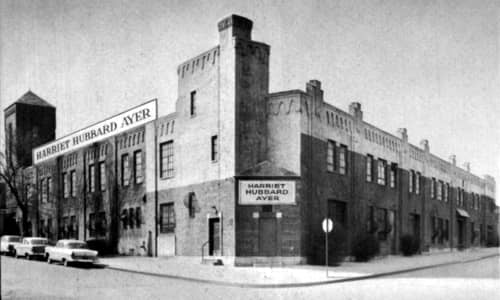
Above: 1958 Ayer and Milkmaid factory Long Island City, New York.
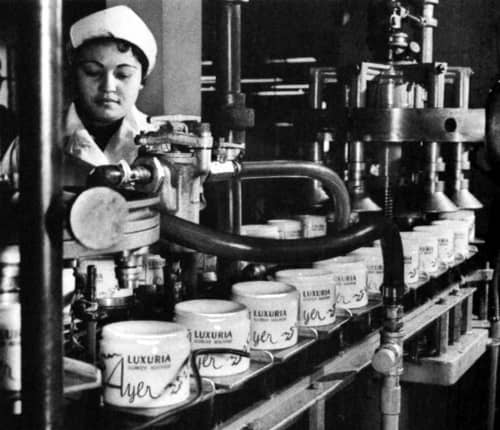
Above: 1962 Filling jars of Luxuria in the factory at Long Island City, New York.
There is very little that can be said regarding the development of the Harriet Hubbard Ayer line while it belonged to Nestle-LeMur apart from the addition of six hair-care products: Ayer-Curl, Colorotone, Ayer Color Rinse and three aerosols – Midas Touch Hair Make-up, Lavender Lace Sachet Mist and Angel-Net Hair Spray.
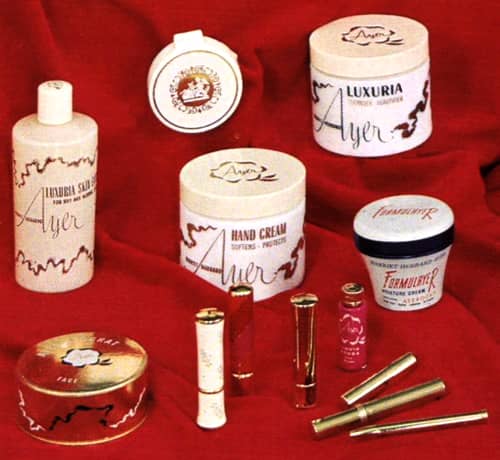
Above: 1964 Harriet Hubbard Ayer cosmetics.
By the early 1960s Nestle-LeMur had realised that the potential for growth for Harriet Hubbard Ayer was limited and it sold the division in 1967 as part of a broad rationalisation of a number of its subsidiaries. From now on the cosmetics part of its business would concentrate on hair-care products, men’s toiletries and budget brands.
French Unilever
Although the situation for Harriet Hubbard Ayer in the Americas went from bad to worse, things were brighter for the Unilever owned business based in Paris, France.
About one-third of Unilever’s European cosmetics and toiletry sales were in France, in part due to its ownership of Thibaud Gibbs which it acquired in 1956. By 1965, the products of the French-based branch of Harriet Hubbard Ayer were sold in seventy countries around the world and sales had risen from £60,000 in 1949 to £600,000 in the early 1960s (Chemist and Druggist, June 22, 1968).
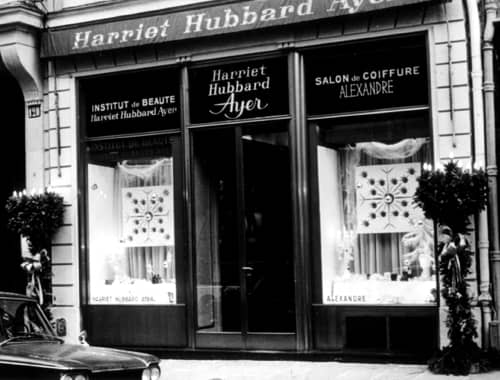
Above: 1968 Harriet Hubbard Ayer Institut de Beauté and Salon de Coiffure at 120 Rue du Faubourg, Saint-Honoré, Paris. The move to the new salon occurred no later than 1963.
However, even here it was not all plain sailing. National distribution of Harriet Hubbard Ayer products in Britain did not recommence until 1955. The long absence of Harriet Hubbard Ayer from the market there and increased competition from American brands meant that the company struggled and, after going through numerous distributors, the London arm of Harriet Hubbard Ayer announced they were withdrawing from the British market in 1970. Withdrawal from other markets followed; sales in Australia for example seem to have ceased sometime in the early 1980s. Fortunately, Harriet Hubbard Ayer was able to maintain its businesses on the continent so the line did not die.
Skin-care
Harriet Hubbard Ayer (France) embraced many of the prevailing ideas in French cosmetics, in particular the use of biological materials. Examples include plant extracts like camomile, which were incorporated into a number of Harriet Hubbard Ayer cosmetics, and embryo extracts which formed the basis of the company’s Embryogen treatment for wrinkled skin.
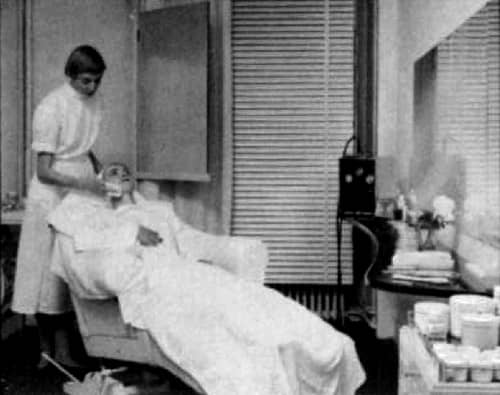
Above: 1958 Facial treatment room in the Harriet Hubbard Ayer Paris salon.
If we compare the skin-care routines for Harriet Hubbard Ayer (France) in the later part of the 1950s with the routine used in the 1940s we can see a number of differences: Cleanse Ayer has replaced Luxuria as the preferred cleanser in morning treatments; Night Cream is now used on all skin types; and Ayerol, a skin cream for pimples and acne which may have contained azulene, was recommended for greasy or mixed skin.
Normal Skin:
Night
Cleanse with Luxuria then wipe off with Cleansing Paper or a fine cloth. Repeat.
Massage with Night Cream.
Day
Cleanse with Cleanse Ayer then wipe off with Cleansing Paper.
Pat briskly with cotton-wool soaked in Skin Lotion.
Dry Skin:
Night
Cleanse with Luxuria then wipe off with Cleansing Paper.
Massage with Night Cream, Skin and Tissue Cream, or Formulayer.
Day
Cleanse with Cleanse Ayer then wipe off with Cleansing Paper.
Pat briskly with cotton-wool soaked in Skin Lotion.
Greasy Skin:
Night
Cleanse with Luxuria then wipe off with Cleansing Paper.
Massage with Night Cream or Skin and Tissue Cream.
Two or three times a week wash with Cream Soap and Complexion Brush, rinse and apply Ayerol over the whole face.
Day
Cleanse with Cleanse Ayer.
Tone with Special Astringent applied with cotton-wool soaked in warm water.
Mixed Skin:
Night
Cleanse with Luxuria then wipe off with Cleansing Paper.
Massage with Night Cream or if over forty Skin and Tissue Cream.
Once a week wash with Cream Soap and Complexion Brush, rinse and apply Ayerol over the whole face.
Day
Cleanse with Cleanse Ayer.
Pat briskly with cotton-wool soaked in Skin Lotion but on greasy parts of the skin use Special Astringent applied with cotton-wool soaked in warm water.
For specific problems there was Formulayer for dry skin; Throat Cream and Special Astringent to tighten and strengthen the muscles of the throat and neck; Facial Mask for tired skin; Strawberry Cream for sallowness; Embryo Base and Muscle Oil for wrinkles; Ayerol for pimples and blackheads; and Eye Cream for puffy eyes and crow’s feet.
Also see: Simple Guides to Beauty (c.1956)
A number of products and the claims made for them – like Skin and Tissue Cream, and Muscle Oil – would not have been allowed in the United States where cosmetic companies were subject to the U.S. Food Drug and Cosmetic Act (FD&CA) and the Wheeler-Lea Act, both passed in 1938.
In 1963, Harriet Hubbard Ayer introduced the Miss Ayer skin-care range for younger women which included: Rapid Cleanser, to check blemishes and blackheads; Tonic Lotion, to refresh and purify the skin; Invisible Base, a colourless skin cream used as a powder foundation; and Transparent Powder, which gave the skin a matt finish. A number of these products contained anthemine made from camomile.
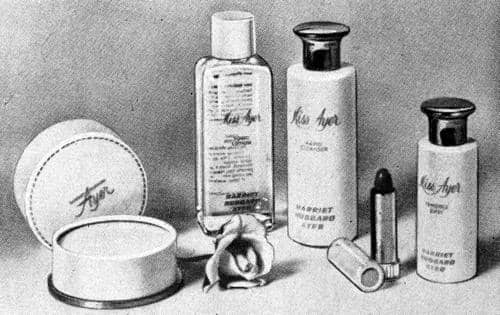
Above: 1963 Harriet Hubbard Ayer Miss Ayer range: Transparent Powder, Tonic Lotion, Rapid Cleanser, Transparent Rose Lipstick, and Invisible Base.
Make-up
The make-up produced by the Harriet Hubbard Ayer (France) moved with the times with new colours introduced as fashions changed. The biggest changes came in the 1960s when new forms of make-up were created that were better suited to younger skin including: Liquid Powder (1963); Transparences, an almost invisible powder (1968); and Miss Ayer Rapid Make-up (1969).
Kosmetic GmbH
In 1978, Unilever combined Harriet Hubbard Ayer (France) with Pierre Robert (Sweden) and Atkinsons (Italy) into a new entity called Parfums Roberre Ltd. based at 44 Portman Square London and then went on to dispose of Harriet Hubbard Ayer to Imperial Kosmetic GmbH in 1985. Although it is no longer found in many countries where it once did business the company is still active to this day in Europe.
Timeline
| 1947 | Lever Brothers buys Harriet Hubbard Ayer Inc. and Harriet Hubbard Ayer Laboratories. |
| 1948 | Salon de Coiffure opens at 89 Rue du Faubourg, Paris. Harriet Hubbard Ayer bottles and jars redesigned. New Products: Pretty Package line for juniors. |
| 1949 | New Products: Complete Home Permanent; Cream Shampoo; Cream Rinse; Ayeristocrat Creamy Foundation; and Dry Skin Cream. |
| 1950 | New Products: Formulayer Moisture Cream. |
| 1951 | New Products: Cleanse-Ayer liquid cleanser; Ayerfast indelible lipstick; First Blush, a liquid foundation; and Sun Tan Lotion. |
| 1952 | Harriet Hubbard Ayer relocated to Lever House at 390 Park Avenue, New York. Entire line of Harriet Hubbard Ayer creams and lotions repackaged. New Products: Ayer Magic, a cream concealer. |
| 1953 | Harriet Hubbard Ayer begins door-to-door selling. New Products: Apricot Cream; and Scented Sun Lotion. |
| 1954 | American Harriet Hubbard Ayer business sold to Nestle-LeMur. Harriet Hubbard Ayer stops door-to-door selling. New Products: Luxuria Creme Powder Pat. |
| 1955 | Canadian branch of Harriet Hubbard Ayer sold to Nestle-LeMur. Milkmaid, Inc. acquired by Nestle-LeMur and integrated with Harriet Hubbard Ayer. Lever Brothers restarts national distribution of Harriet Hubbard Ayer in Britain. |
| n.d. | Ayer Institut de Beauté and Salon de Coiffure moves to 120 Rue du Faubourg, Saint-Honoré, Paris. |
| 1957 | New Products: Flowing Formulayer Moisture Balm. |
| 1959 | New Products: Cristal Facial. |
| 1963 | New Products: Miss Ayer range for younger women. |
| 1965 | New Products: Crème Jaspée. |
| 1967 | Harriet Hubbard Ayer division sold to the Standard Metals Corporation but licensed Unilever France to cover Latin America apart from Mexico. |
| 1968 | New Products: Transparences Face Powder; and Lotion Florale, a skin tonic. |
| 1969 | New Products: Super Moisturising Cleanser; Crème Pour le Cou, a neck and throat cream; and Miss Ayer Rapid Make-up. |
| 1970 | Harriet Hubbard Ayer withdraws from the British market. |
| 1978 | Unilever creates Parfums Roberre Ltd. by combining Pierre Robert (Swedish cosmetics company), Harriet Hubbard Ayer (France) and Atkinsons (Italy). |
| 1985 | Unilever sells Harriet Hubbard Ayer to Imperial Kosmetic GmbH. |
First Posted: 30th March 2016
Last Update: 26th July 2022
Sources
The American perfumer & essential oil review. (1906-1955). New York: Robbins Perfumer Co. [etc.].
The Chemist and Druggist. (1859-). London: Morgan Brothers.
Harriet Hubbard Ayer. (n.d.). Simple Guides to Beauty [Booklet]. UK: Author.
Nestle-LeMur. Annual Reports 1954-1967.
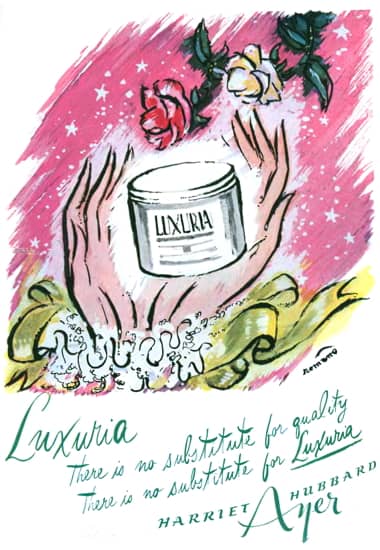
1944 Harriet Hubbard Ayer Luxuria.
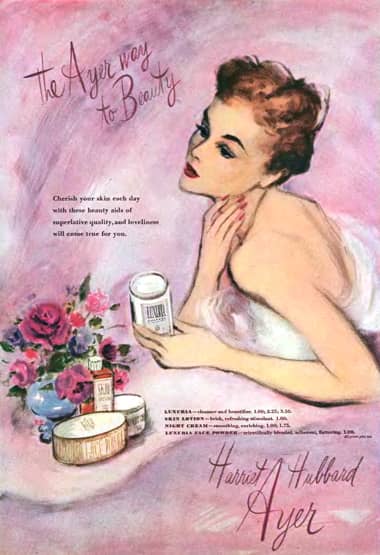
1945 Harriet Hubbard Ayer. The Ayer way to Beauty.
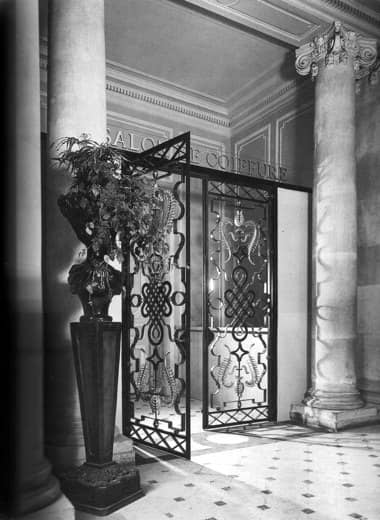
1946 Entrance gate to the Harriet Hubbard Ayer Salon de Coiffure, in Paris.
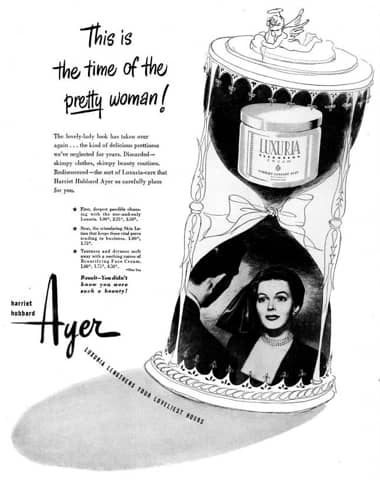
1947 Harriet Hubbard Ayer Luxuria.
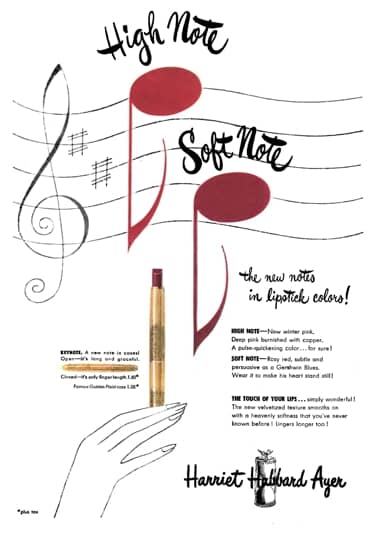
1948 Harriet Hubbard Ayer lipsticks in long, pencil type Keynote cases.
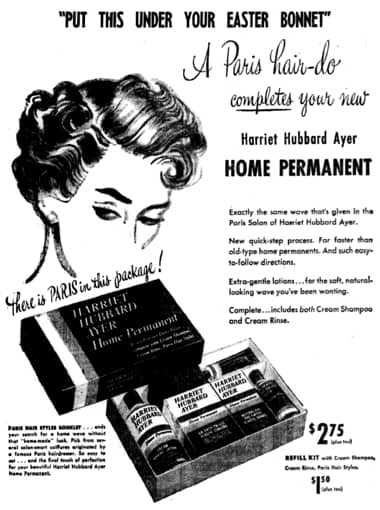
1949 Harriet Hubbard Ayer Home Permanent.
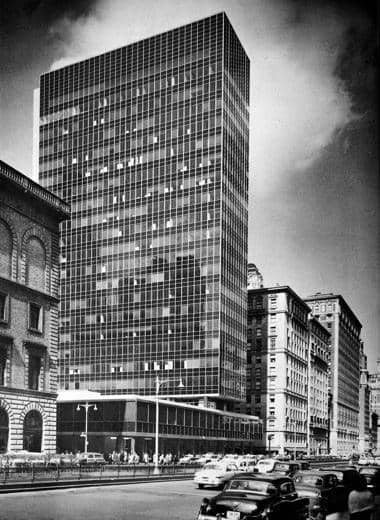
Lever House at 390 Park Avenue, New York designed by Gordon Bunshaft and Natalie de Blois of Skidmore, Owings and Merrill.
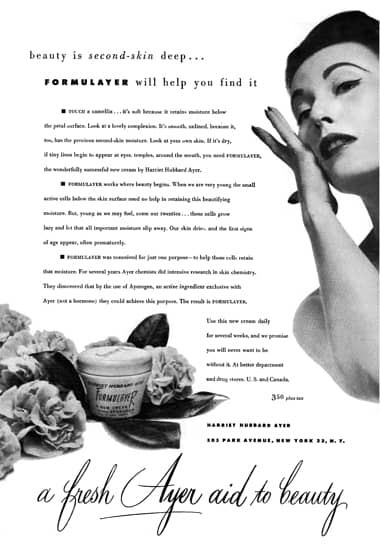
1951 Harriet Hubbard Ayer Formulayer.
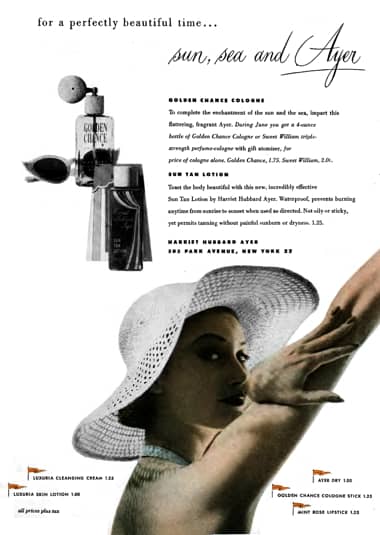
1951 Harriet Hubbard Ayer Sun Tan lotion.
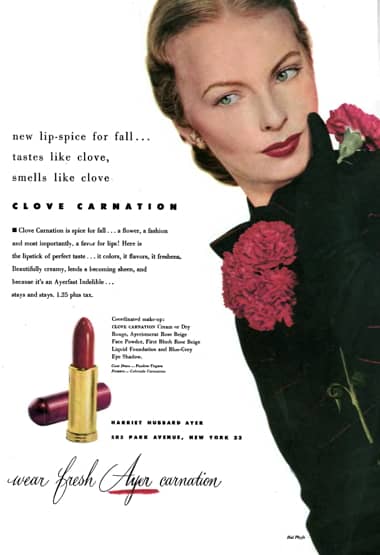
1951 Harriet Hubbard Ayer Clove Carnation Lipstick. This was the second flavoured lipstick produced by Harriet Hubbard Ayer, the first being Mint Rose.
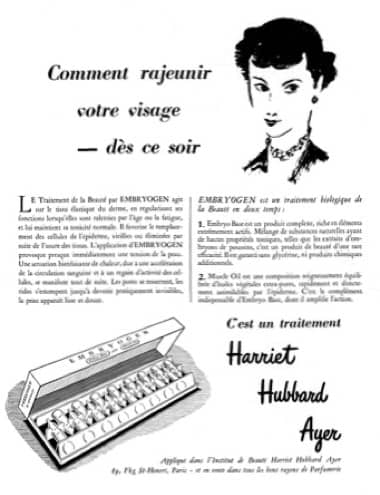
1952 Harriet Hubbard Ayer Embryrogen Treatment containing 8 vials of Embryo Base and 8 vials of Muscle Oil.
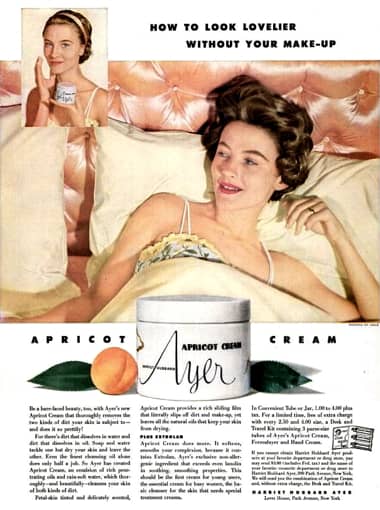
1953 Harriet Hubbard Ayer Apricot Cream.
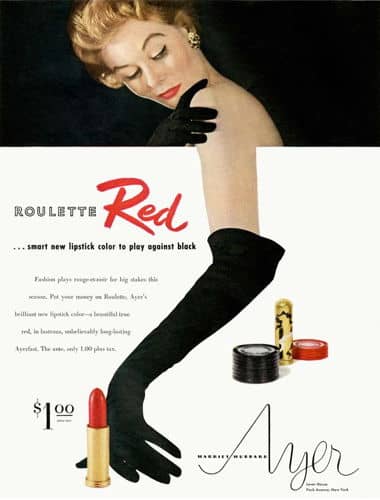
1953 Harriet Hubbard Ayer Roulette Red Lipstick.
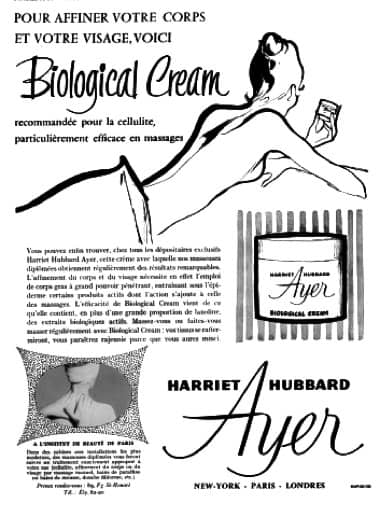
1955 Harriet Hubbard Ayer Biologicals.
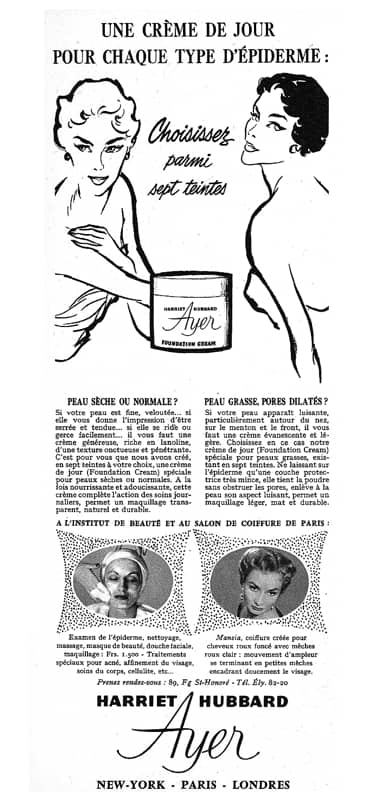
1957 Harriet Hubbard Ayer Foundation Cream.
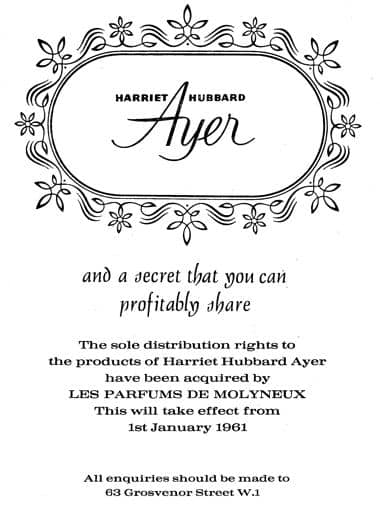
1960 Molyneux announce they have taken over the distribution of Harriet Hubbard Ayer.
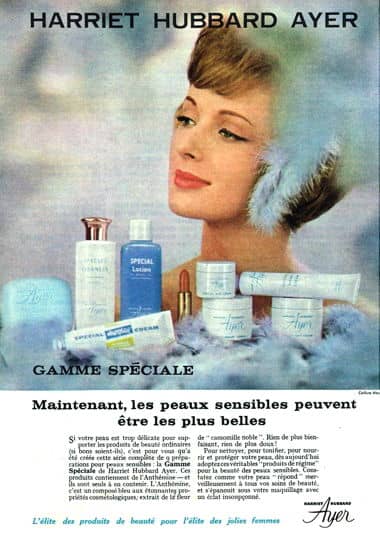
1962 Harriet Hubbard Ayer Special Range for sensitive skin containing anthemine (camomile). The six products in the range were: Special Cleanser, Special Lotion, Special Soap, Special Night Cream, Special Day Cream, and Special Hand Cream.
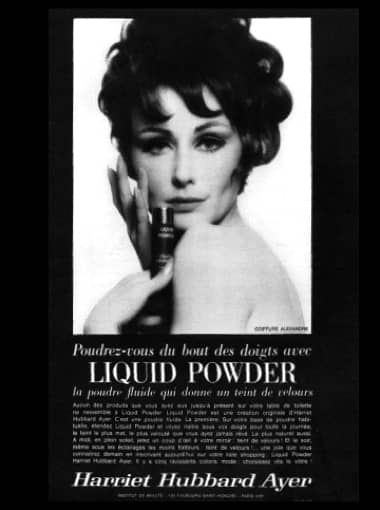
1963 Harriet Hubbard Ayer Liquid Powder, a matt velvet make-up in Arctic, Baltic, Atlantic, Adriatic and Pacific shades.
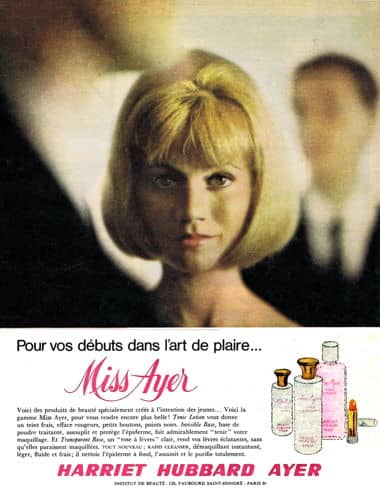
1963 Harriet Hubbard Ayer Miss Ayer.
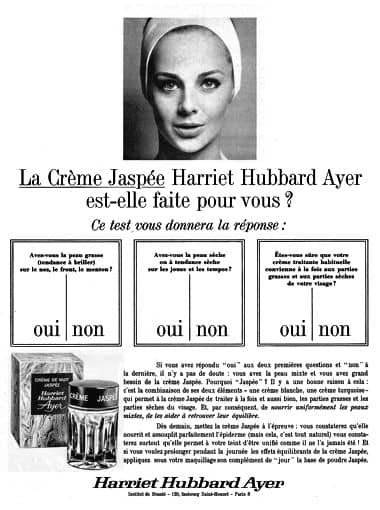
1965 Harriet Hubbard Ayer Crème Jaspée. Also known as Base de Poudre Jaspée the product was a skin cream that could also be used as a powder base. The name originates from the product’s resemblance to jasper stone (pink mottled with blue). The pink part was ‘rich in nutrients’ designed to ‘strengthen and feed dry areas’ while the blue part was said to ‘correct oily areas’.
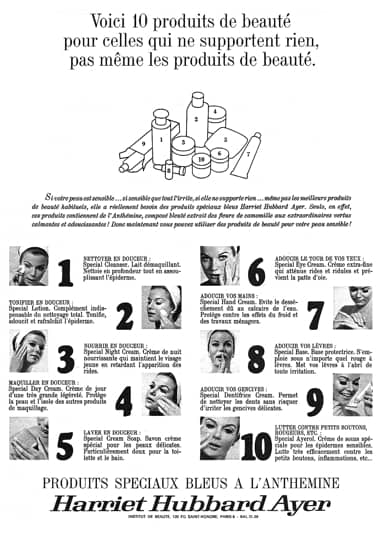
1966 Harriet Hubbard Ayer cosmetics containing anthemine (camomile).
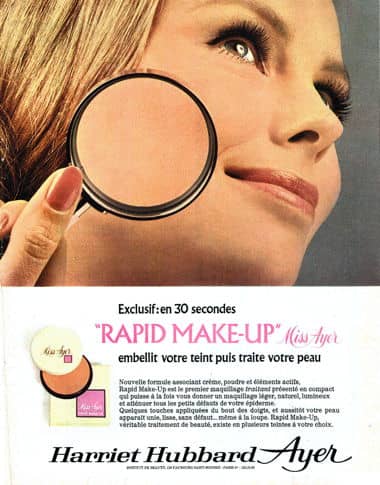
1969 Miss Ayer Rapid Make-up.
